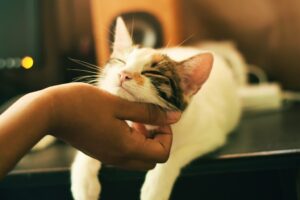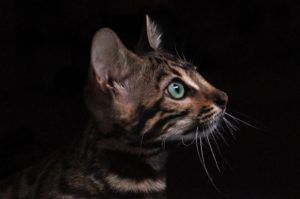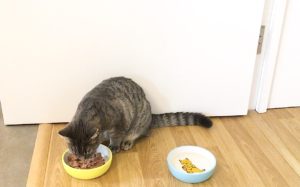Cat’s litter boxes can be tricky, choosing which litter and litter box to use, training a cat to use it, and remembering to clean it often enough. What if you could train your cat to use the same toilet as you? It can be done, but teaching a cat how to use the toilet is quite tricky. It goes against a cat’s natural instincts, so it might take some work from both of you to get it right. However, if you manage to get the training right then you and your cat won’t have to deal with the litter box training ever again.
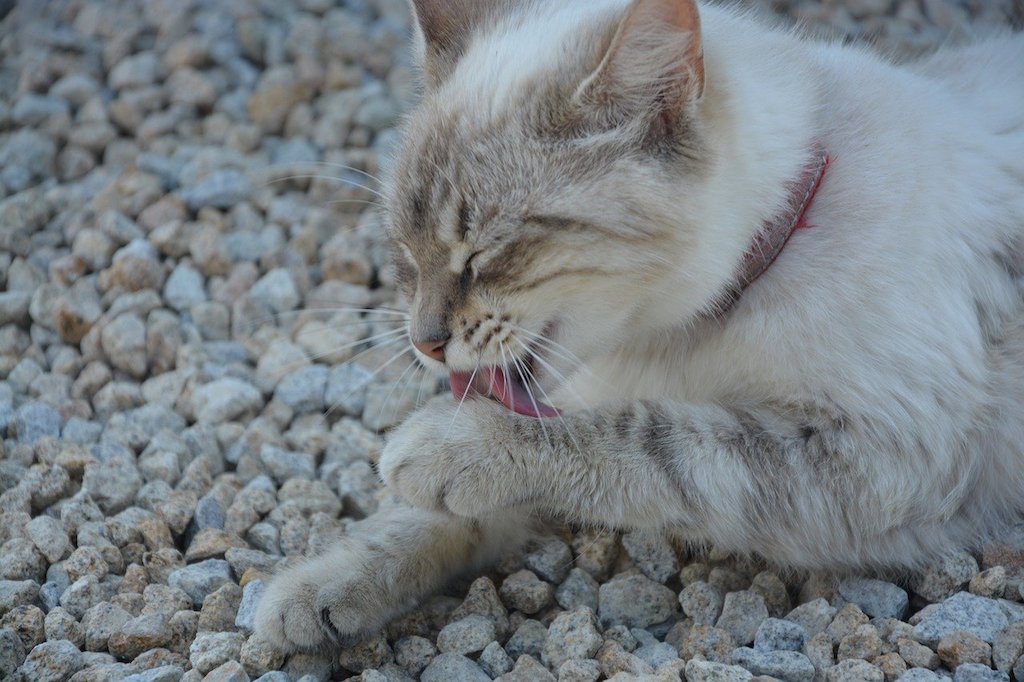
Training your kitten or cat to use a toilet takes a while. You need to acquire the equipment, and then gradually transition your cat into using the actual toilet. It might take some time. However, if you’re already doing some cat training then this is going to be quite a bit simpler. Your cat might take some time to get used to things. This is everything you’re going to need to know to train your kitten or cat to use the toilet:
What Will You Need to Train Your Cat to Use the Toilet
To train your cat to use the toilet, there are some supplies that you’re going to need. Cats don’t naturally recognise the toilet as a place to go. Using a human toilet actually goes against your cat’s natural instincts. This doesn’t mean that you can’t teach your cat to use a toilet. However, some supplies are needed to help transition them from a litter box.
The main thing you’re going to need is a cat training seat. These are things that you slot over the seat which adapts it for use by a cat. Without one, your toilet seat bowl is going to be difficult for your cat to comfortably use, it isn’t exactly designed for use by people or animals their size. The training seat works by being easier to use over time. The hole in the center of the training seat gets larger over time. This teaches your cat how to use a regular toilet. At first, there will be litter in this bowl. Over time though, your cat will learn how to use the toilet without litter.
In terms of what training seat you get to use, there are options like the Litter Kwitter. This is one of the most popular options out there for training your cat to use the toilet.
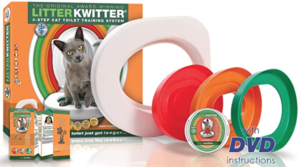
View on Amazon
However, there are more budget friendly training kits available too. Ones like this work fine and it is a lot more affordable than the Litter Kwitter. Your choice of training kit though isn’t as important as going through the training successfully!
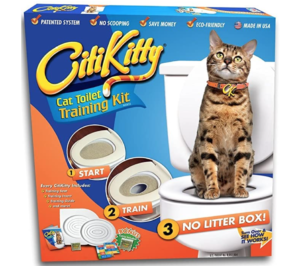
View on Amazon
How to Train Your Cat to Use the Toilet
1. Position the Litter Box
The first part of training your cat to use the toilet is to train them to use a litter box in a similar situation. Essentially you need to get them to use a litter box in the bathroom at first. This prepares them to start using the actual toilet. Moving the litter box into the room should be simple enough. Most cats can roll with the litter box moving without getting too upset about things! What might be harder for your cat though, is moving the box higher. You will need to position the box so they become accustomed to using a litter box at that height, otherwise the toilet won’t feel accessible.
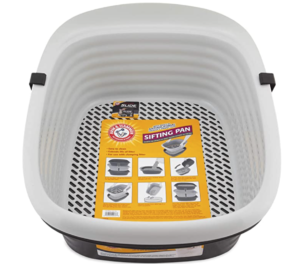
View on Amazon
Gradually, over the course of a few weeks, raise the litter box up in height. You can do this just by stacking it on top of things. Be sure that the litter box is stable and level, however. The last thing you want is for the little box to topple over or be lent to one side when your cat is using it.
This process can be a bit slow. However, it is important for helping your cat to adjust to actually using the bathroom. Take it as slow as you need to. If your cat seems overwhelmed by the change, then slow things down.
After your cat has gotten used to using the litter box at the height of the toilet, it is time to move the litter box on top of the toilet seat. This stage should last for a week or so, until your cat is completely comfortable climbing on top of the toilet to use their litter box.
2. Remove the Litter Box and Start Using the Training Seat
Once your cat has gotten used to going to the toilet on top of the actual toilet, you can switch over to the training seat. At first, this will have a pan on it which will still use litter. Most of the time people use flushable litter for this step. This litter will still need changing and cleaning regularly as there is no hole to allow things to filter through. This stage is a bit of a leap for your cat, but if the earlier step went to plan then it should be a smooth enough transition. Treat your cat to World’s Best Cat Litter so she can have an easier transition with this clumping cat litter!

View on Amazon
One of the most important things to keep in mind for this step is keeping things secure. The training seat needs to be safely attached. If it isn’t, your cat could fall which would be a big step back from them using the seat.
3. Make the Hole Bigger
Once your cat has begun using the tray on top of the toilet without any problems, you can step forward. The training seat can be switched out for gradually smaller and smaller seats. At the start, it will have a small hole in it, followed by a bigger and bigger one.
You need to start putting less litter into the tray as time passes too. This bit will have to be slow, as your cat might react badly if the litter disappears. Since the hole will get larger, eventually your cat will notice that they’re eliminating into the water rather than into the litter. Keep at this stage, for as long as it takes for your cat to get through all of the changes. While there isn’t too much to think about here, it is probably going to be the longest step in the entire process.
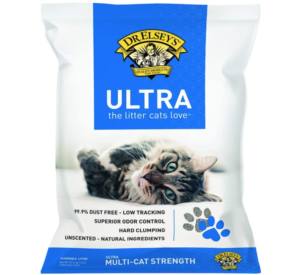
View on Amazon
4. Transition the Training Seat into the Toilet Bowl
After you’ve ran through the smaller training seats, your cat should be acclimatized to getting close to the bowl. Once you’re happy that your cat feels secure in the new system, then you can take away the training seat entirely. If you’ve gone through the transition in a gradual way, this step should be pretty simple. The largest hole in the training seat is nearly as open as the normal toilet seat. If your cat begins avoiding the toilet entirely though, you might need to go back to the training seat for a little longer. However, with some persistence eventually your cat should get through this. Once this step is done, your cat is going to be fully trained to go to the toilet on their own.

View on Amazon
Pros and Cons of Training a Cat to Use the Toilet
Training a cat to use the toilet can make things a lot simpler for you. However, there are some pros and cons to consider before you start. There are some things that you need to know first as they can make it a bit more complicated that initially seems. This is what you need to know:
Pros
- You don’t have to deal with a litter box anymore.
- Saves money and time with litter for the box.
- Can help cats who are picky about what type of litter they use.
- Fun trick for your cat to learn.
Cons
- Cats naturally prefer to bury their waste. This can make toilet training quite difficult for them, since they’re fighting their natural instincts.
- Some cats just won’t get along with this kind of training.
- Cats can fall when using a human toilet, this can be particularly dangerous for older cats.
- Removing the litter box can cause problems if they need to go but can’t get access to your toilet.
- Toilet training a cat at your home won’t necessarily translate to other toilets and they might get used to not using a litter box. This could become a problem if your cat needs to stay somewhere such as when you’re away.
This doesn’t mean it is a bad idea to train your cat to use the toilet, just that you need to think over what’s right for your cat. If your pet is young and you avoid any problems, then they’ll likely be fine to learn how to use the toilet.
Is Toilet Training Your Cat Right for You?
Toilet training a cat should only really be done once it is old enough to grasp the process. If you’re gone through pros and cons and decided that this is the correct move for you, then the training is going to take some time and dedication. Eventually, a cat should learn how to use the toilet if you put the work in. If you decide that this training is right for you and your cat, then it can save a lot of trouble in cleaning out litter.


